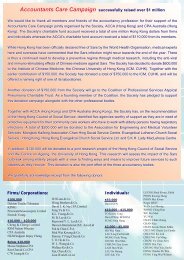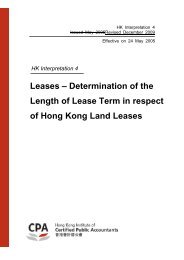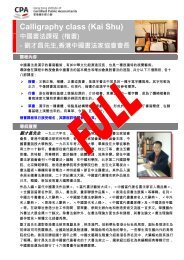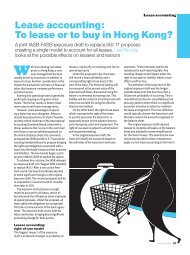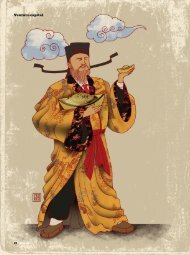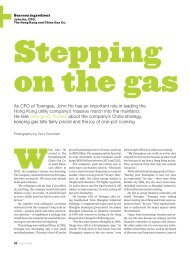Flagship fashion - Hong Kong Institute of Certified Public Accountants
Flagship fashion - Hong Kong Institute of Certified Public Accountants
Flagship fashion - Hong Kong Institute of Certified Public Accountants
You also want an ePaper? Increase the reach of your titles
YUMPU automatically turns print PDFs into web optimized ePapers that Google loves.
Latin leverage<br />
George W. Russell looks<br />
at how South American<br />
vineyards are edging<br />
into <strong>Hong</strong> <strong>Kong</strong>’s market<br />
With decades <strong>of</strong> immigration<br />
from France, Italy and Spain,<br />
it’s no surprise that South<br />
Americans are handy at winemaking. Many<br />
<strong>of</strong> the newcomers settled vast countries<br />
with varied terroir, enabling them to experiment<br />
with grapes best suited to their new<br />
environments.<br />
As a result, wine from South America<br />
is <strong>of</strong>ten made from grapes long neglected<br />
in Europe, such as Carménère and Tannat.<br />
More familiar varieties include Malbec,<br />
Pinot Noir and Chardonnay.<br />
Argentina<br />
The region around Mendoza, in the country’s<br />
central-west, accounts for about 70 percent<br />
<strong>of</strong> Argentina’s wine production. Malbec<br />
dominates, with significant quantities <strong>of</strong><br />
Viognier and Merlot.<br />
The Valentin Bianchi estate is known for<br />
consistently good value, and, among reds,<br />
the Elsa Syrah 2010 (HK$60, Montrose<br />
Wines) is no exception. The Astica Sauvignon<br />
Blanc Semillon 2010 (HK$99, Soho<br />
Wines) has a light, bright quality ideal for<br />
fish dishes.<br />
White wines from Mendoza <strong>of</strong>ten have<br />
a certain tartness about them. The Alamos<br />
Chardonnay 2010 (HK$75, Watson’s Wine<br />
Cellar) is pineapple-crisp, while the Catena<br />
Alta Chardonnay (HK$388, Watson’s) is rich<br />
and complex.<br />
Brazil<br />
So far, the only Brazilian wines that this<br />
correspondent has seen in <strong>Hong</strong> <strong>Kong</strong> come<br />
from Miolo, which distributes a Riesling,<br />
a Touriga, a sparkling white and its Cuvée<br />
Giuseppe blended red. Wines from Casa<br />
58 May 2012<br />
After hours<br />
The Andes Mountains<br />
overlook a vineyard in<br />
central Argentina<br />
Valduga, which recently launched a new<br />
Vinho Rose made from Merlot grapes, can<br />
also be found here. The estate is also known<br />
for its uncomplicated sparkling wines like the<br />
Espumante Brut 130. Other wineries to keep<br />
an eye out for include Boscato, Lidio Carraro,<br />
Miolo, Pizzato, Salton and ViniBrasil.<br />
With the football World Cup being held<br />
in Brazil in 2014, the country is expected to<br />
begin heavily marketing its exports next year.<br />
Chile<br />
There are more than 100 big wineries in<br />
Chile’s 15 wine-growing valleys. Aficionados<br />
in <strong>Hong</strong> <strong>Kong</strong> will be familiar with two major<br />
producing areas, the Valle Central and the<br />
Maipo Valley. However, Chile’s terroir ranges<br />
from the semiarid San Antonio Valley, known<br />
for its whites, to the rugged Aconcagua Valley,<br />
home to the iconic Carménère grape.<br />
While the Carménère grape originated<br />
in Bordeaux, only Chile is using it in large<br />
quantities (though there has been some<br />
replanting in Italy). The Casa La Joya<br />
Reserve Carménère 2009 (HK$139, Soho)<br />
from the Colchagua Valley is an aromatically<br />
complex red with a peppery finish.<br />
Baron Philippe de Rothschild started<br />
a joint venture with Concha y Toro that<br />
has resulted in several premium products,<br />
including the Almaviva Cabernet Sauvignon<br />
2006 (HK$700, Platinum Wines).<br />
The Luis Felipe Edwards Chardonnay<br />
2011 (HK$54, Montrose) is a simple, peachy<br />
white ideal for summer barbecues. Winemaker<br />
Eduardo Chadwick’s full-bodied<br />
Arboleda Chardonnay 2008 (HK$145, Wat-<br />
son’s) is redolent <strong>of</strong> sweet lemons and apples<br />
ahead <strong>of</strong> a tart finish.<br />
Uruguay<br />
Uruguay is poised to be the next big New<br />
World exporter. With nearly 300 mostly<br />
small producers, Uruguay has been a major<br />
supplier to Brazil and other South American<br />
countries for decades. More recently, it has<br />
ramped up exports to North America.<br />
It is chiefly known for robust reds that<br />
accompany the country’s beef- and lambbased<br />
diet. The Tannat grape is originally<br />
from southwestern France but now is one <strong>of</strong><br />
the most prominent Uruguayan varieties,<br />
accounting for at least 40 percent <strong>of</strong> output.<br />
The Viña Progreso Sueños de Elisa Tannat<br />
2011 (about HK$100, Chateau Lamma),<br />
a product <strong>of</strong> a joint venture between Burgundy<br />
winemaker Jean-Charles Boisset<br />
and Uruguay’s pioneering Pisano family,<br />
can also be found in <strong>Hong</strong> <strong>Kong</strong>.<br />
Other countries<br />
Should Uruguayan and Brazilian wines make<br />
a dent in the market, expect more countries<br />
to follow suit. Bolivia, Ecuador and Paraguay<br />
all have considerable wine industries.<br />
The tropical north <strong>of</strong> the continent is<br />
largely unsuited to viticulture, although<br />
Peru produces some wine – most <strong>of</strong> the harvest<br />
is used to make Pisco, a grape brandy –<br />
and Venezuelan wineries make reds, mainly<br />
from Petit Verdot grapes.<br />
George W. Russell, editor at large <strong>of</strong> A Plus,<br />
can’t wait to taste Guyanese carambola wine.



